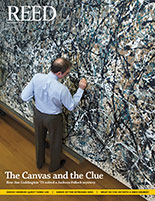
IRIS login | Reed College home Volume 92, No. 3: September 2013
Reediana
Revolutions in Twentieth-Century Physics (Cambridge University Press, New York, 2013)
Prof. David J. Griffiths [physics 1978–2009]
By William Abernathy ’88
Whatever surprises physics delivers in the 21st century, the 20th is going to be one tough act to follow. At the turn of the last century, physics was in danger of becoming an intellectual backwater: our watchwork universe seemed clearly governed by long-established Newtonian principles. Promising young scientists were counseled to avoid the discipline, as so few discoveries remained to be made. Then, in 1905, an unknown Swiss patent clerk published a paper entitled “Zur Elektrodynamik bewegter Körper” (On the Electrodynamics of Moving Bodies). Better known as the theory of special relativity, it pretty much changed everything. Physics went nonlinear.

Prof. David Griffiths’ new book, Revolutions in Twentieth-Century Physics, performs double duty as a layman’s physics text and as an intellectual history of the century that most fundamentally altered humankind’s understanding of the universe. Deceptively slim, but powerfully expository, this book provides an overview of the mind-bending discoveries of 20th-century physics in just five chapters. Reedies of a certain vintage will recognize the first of these chapters as a brief refresher of the foundational Newtonian physics of Nat. Sci. 110, with Griffiths whisking the reader past a selective survey of classical physics, from simple mechanics to wave dynamics. With physics (circa 1900) under your belt, Griffiths draws his machete and hacks a four-chapter trail into the 20th-century’s four great physics revolutions: relativity, quantum mechanics, particle physics, and cosmology.
Griffiths seeks to introduce these concepts’ beauty, strangeness, and curious symmetries without penning a shallow, “gee-whiz” physics review. Presenting the gist of these recondite topics without demanding too much of a lay reader is a delicate balancing act, and for the most part, he gets it right (though an answer guide would at times be welcome). Griffiths has managed to set aside the most fearsome aspect of advanced physics—the advanced math—with a book that demands only arithmetic and algebraic understanding. While the often counterintuitive discoveries of 20th century physics had to be demonstrated with hairy mathematics and elaborate experiments, once proven, most can be expressed in plain algebra. Griffiths’ tone is gentle and conversational, and he’s refreshingly relaxed about shrugging his shoulders and admitting when he doesn’t have answers. Usually, it’s because no one does.
For readers with the math chops to pursue these principles more deeply, Griffiths has already written highly regarded and widely adopted introductory textbooks on quantum mechanics, electrodynamics, and elementary particles. For the rest of us, Revolutions in Twentieth-Century Physics will prove a useful and instructive field guide.

LATEST COMMENTS
steve-jobs-1976 I knew Steve Jobs when he was on the second floor of Quincy. (Fall...
Utnapishtim - 2 weeks ago
Prof. Mason Drukman [political science 1964–70] This is gold, pure gold. God bless, Prof. Drukman.
puredog - 1 month ago
virginia-davis-1965 Such a good friend & compatriot in the day of Satyricon...
czarchasm - 4 months ago
John Peara Baba 1990 John died of a broken heart from losing his mom and then his...
kodachrome - 7 months ago
Carol Sawyer 1962 Who wrote this obit? I'm writing something about Carol Sawyer...
MsLaurie Pepper - 8 months ago
William W. Wissman MAT 1969 ...and THREE sisters. Sabra, the oldest, Mary, the middle, and...
riclf - 10 months ago